- The Central Indochina Dry Forest ecoregion is rapidly being consumed by large agribusiness concessions, threatening the Pileated Gibbon, Asian Elephant, Fishing Cat and many other unique animals.
- SMART, a new cutting edge law enforcement monitoring tool, developed by a consortium of conservation organizations including the Wildlife Conservation Society, is now helping strengthen wildlife protection standards in Cambodia. The number of Pileated Gibbon poaching cases have fallen drastically as a result.
- A Cambodian moratorium on new agricultural concessions, a plan for a major new protected area that will connect prime Pileated Gibbon habitat, and vibrant community engagement in conservation are all brightening the future for this Endangered gibbon.

The long-limbed, canopy-swinging, duet-singing gibbons of Southeast Asia are under threat as industrial agriculture eats into their forest habitat. Palm oil plantation expansion is famously bad news for all sorts of wildlife, as are the new sugar and rubber plantations also driving deforestation across the region. But gibbon species are especially vulnerable: the cutting of trees makes their favored high-flying locomotion impossible — a potentially fatal plight for this overlooked great ape.
Finding the balance between economic development, industrial agricultural production, and great ape conservation is an urgent challenge facing governments and conservation organizations in many parts of Asia and Africa, as highlighted by the recent report, “State of the Apes: Industrial Agriculture and Ape Conservation”.
One such struggle is playing out in the Northern Plains of Cambodia, where the Pileated Gibbon (Hylobates pileatus) is the ape at risk. There, a mixture of evergreen and deciduous forest is home to not only H. pileatus, but a host of other species pressured by encroaching agribusiness. This besieged region includes one of the largest remnants of deciduous dipterocarp forest — dubbed the Central Indochina Dry Forest ecoregion — that once extended across much of Thailand, Vietnam, Laos and Cambodia.
The ecoregion “supports populations of… Giant Ibis and White-winged Duck that have been lost from elsewhere. These birds, and animals like the Pileated Gibbon, are extremely rare on a global scale,” revealed Simon Mahood, a senior technical advisor with the Wildlife Conservation Society (WCS) in Cambodia. “They’re spectacular animals and the Northern Plains is vital for their survival. These areas contain huge trees, themselves globally threatened, which provide food and shelter to the gibbons, and nesting places for storks and birds like the White-winged Duck.”

“These forests were formerly home to very large herds of large mammals, [and they] have been compared to the savannas of East Africa,” said Alistair Mould, technical advisor to the WCS Northern Plains project. Many of the forest species are on the IUCN red list, including the Asian Elephant (Elephas maximus); the Dhole (Cuon alpinus), a wild dog; the Banteng (Bos javanicus), a wild cattle species; and the Fishing Cat (Prionailurus viverrinus). This is a “unique and critically important” habitat, Mould said.
But among them all, the gibbon stands out. “The Pileated Gibbon is a flagship for the conservation of semi-evergreen forest in the Northern Plains,” Prak Munny, WCS Cambodia Deputy Director, stated simply.
A stand-out species with no place to go
The gibbons live in small family groups, eat a largely fruit-based diet, and sing melodious duets at dawn and dusk. Their songs, which can travel great distances through the forest, are among the most complicated of any mammal. They sing to help maintain strong bonds between mated pairs, and to defend their territories. Male Pileated Gibbons have black fur with pale hands and eyebrows; females have black chests and faces, with lighter fur elsewhere. Threatened by habitat loss, their good looks have also landed them a place in the pet trade.
Pileated Gibbons are classified as Endangered by the IUCN. As their habitat rapidly shrinks, their population has declined by more than 50% over three generations (a mere 45 years). Their range extends into Thailand and Laos, but Cambodia has the largest remaining population, with an estimated 35,000 individuals, making it a hot spot critical to the conservation of the species.
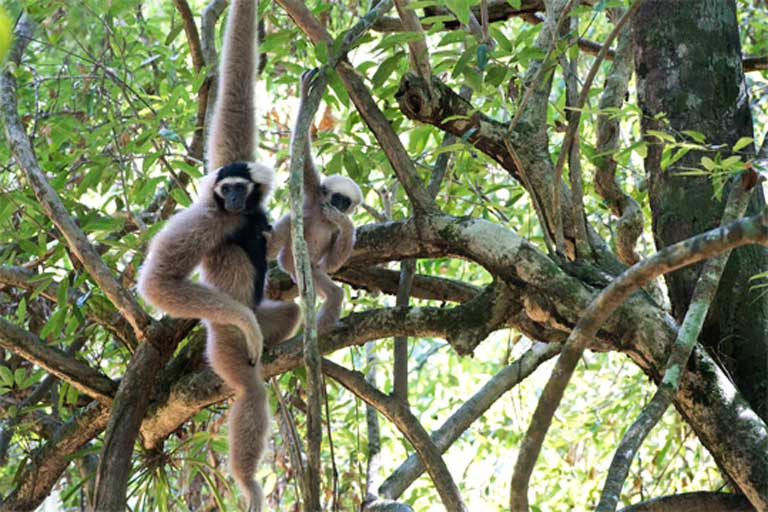
“The two most significant threats to Pileated Gibbon in Cambodia are habitat loss, driven by agro-industrial plantations, land grabbing and land speculation, and commercially-driven hunting,” Mould said. “Gibbon range is becoming increasingly fragmented with increasing pressure to convert much of Cambodia’s forest to industrial plantations and subsistence agriculture. Over the last five years, there has been an increase in the rate of loss of intact forest in the Pileated Gibbon range west of the Mekong in Cambodia.”
These losses are being fuelled by economic land concessions, granted by the Cambodian government as part of a drive to develop industrial agriculture. Almost all these concessions — usually, forest clearing for rubber plantations — fall within the gibbon’s range.
Concessions are now even found within protected areas, including Cambodia’s largest, the Kulen Promtep Wildlife Sanctuary, a 402,500 hectare (1,554 square mile) reserve in the Northern Plains. Up to 11 concessions have been granted so far to Cambodian, Malaysian, Korean and Thai companies. These cover more than 60,000 hectares (231 square miles), almost 15% of the reserve’s area, according to data published on Open Development Cambodia, an online hub of publicly-available information concerning social and economic development in the country.
The future for economic land concessions is unclear. The government has promoted the conversion of forests to agriculture in recent years, with the nation seeing a significant ratcheting up of deforestation. National figures for the area within concessions range between 1.2 and 2 million hectares (4,633 to 7,722 square miles). The State of the Apes report suggests that rubber plantations alone will quadruple in area by 2050 across all of Southeast Asia.
Hope for the Pileated Gibbon and the Dry Forest
Amid all the dire news, there is also some good news. In Cambodia, at least, forests have been granted a reprieve for the time being: “A government sub-decree was recently passed in Cambodia that placed a moratorium on the granting of [new] economic land concessions — no new agro-industrial plantations are planned for the Northern Plains,” Mould told Mongabay. However, existing concessions within the Northern Plains “have continued to expand operations.”
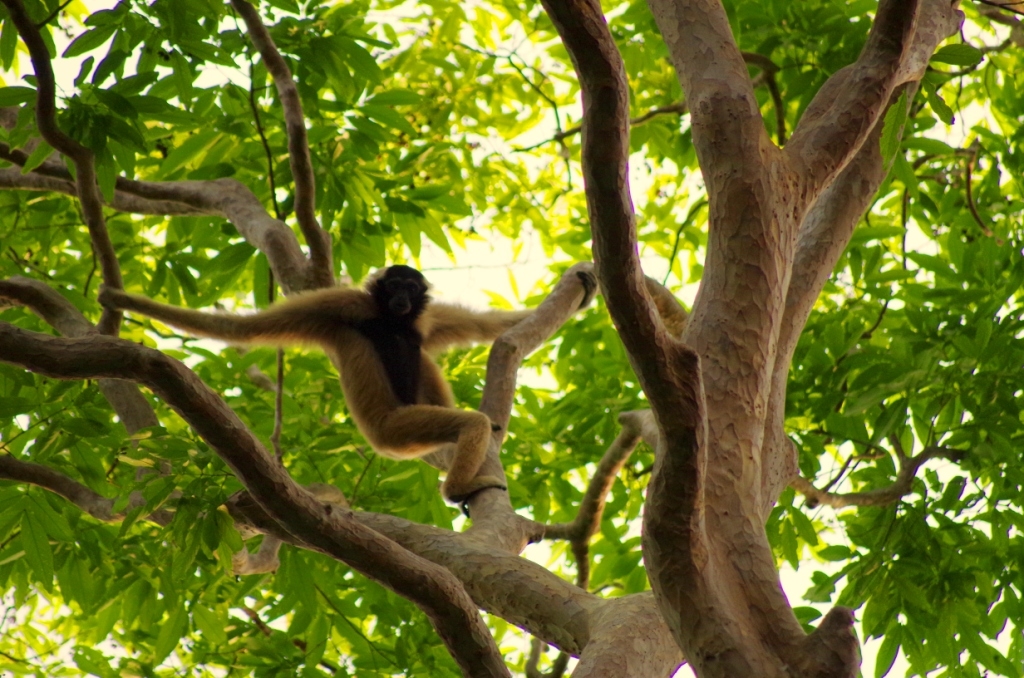
The Northern Plains landscape, which encompasses the Kulen Promtep Wildlife Sanctuary and the Preah Vihear Protected Forest, has been a focus of WCS’s conservation activities since 1999. Monitoring and conserving the Pileated Gibbon has been a WCS priority for the past six years, a project that has received support from the US Fish and Wildlife Service.
Mould and his Northern Plains team have implemented a three-pronged approach to protecting the gibbons: adopting new technology for more effective monitoring, building the capacity of rangers and law enforcement patrols, and promoting participatory land use planning so communities have a voice in how their land is used.
“Working with communities and local government authorities to preserve important semi-evergreen habitat is crucial for the survival of Pileated Gibbons in the Northern Plains,” said Mao Khean, WCS biodiversity monitoring officer.
A SMART conservation plan
Although economic land concessions generally spell doom for the forests within them, they also attract migrant workers to the area, and this demographic shift has knock-on effects on how surrounding land is used and on how much hunting takes place. Hunting patrols and effective law enforcement are therefore a vital part of any conservation project.
“A key achievement of the Northern Plains Pileated Gibbon Project has been improving [the] effectiveness and efficiency of law enforcement and wildlife monitoring patrols,” Mould said. The project has benefited from SMART (Spatial Monitoring And Reporting Tool), a new monitoring approach developed by a consortium of organizations including WCS. In comparison with previous monitoring systems, SMART “is a vastly superior law enforcement monitoring tool,” Mould said.
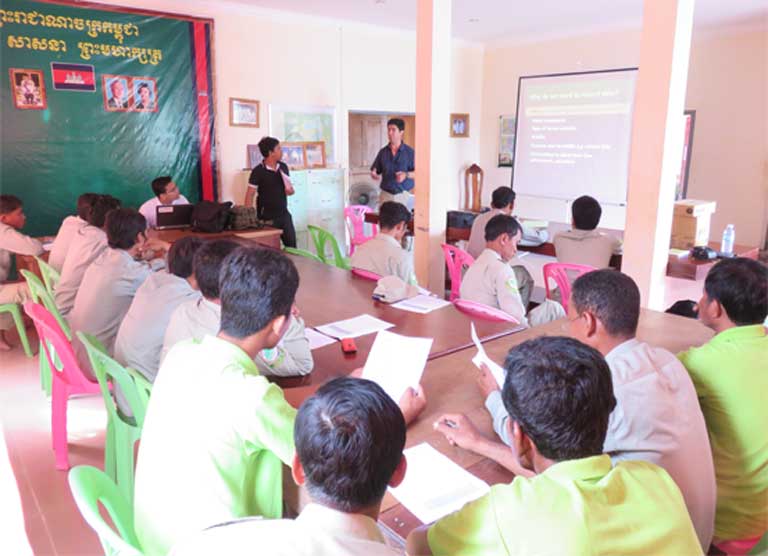
“The SMART approach combines a cutting edge law enforcement monitoring tool with capacity building and a set of protection standards,” Alexa Montefiore, SMART Partnership Program Manager, told Mongabay.
“SMART is designed for those directly responsible for wildlife conservation, from rangers in the field to senior government staff,” she said. “[It] has a powerful analytical, mapping and reporting functionality that enables rapid conversion of patrol data to useful and highly visual information for park management. [This] makes it possible to collect, store, communicate and evaluate data on patrol efforts (e.g. time spent on patrols or areas visited); patrol results (e.g. snares removed or arrests made); and threat-levels (e.g. poaching indicators).”
SMART has been widely adopted around the world, and is being used in 147 projects in 31 countries. “One of our greatest accomplishments is our vast and rapid global adoption,” Montefiore reported. “At the request of protected area and wildlife agencies, SMART is being increasingly scaled up from individual sites to entire protected area networks in a number of different countries worldwide.” A key reason for this success is that “the software is free, open source and can be downloaded by anyone.”
“By putting sophisticated mapping, analysis and reporting capabilities in the hands of those working on the frontlines of conservation, we have provided a comprehensive tool for protecting wildlife,” Montefiore explained.
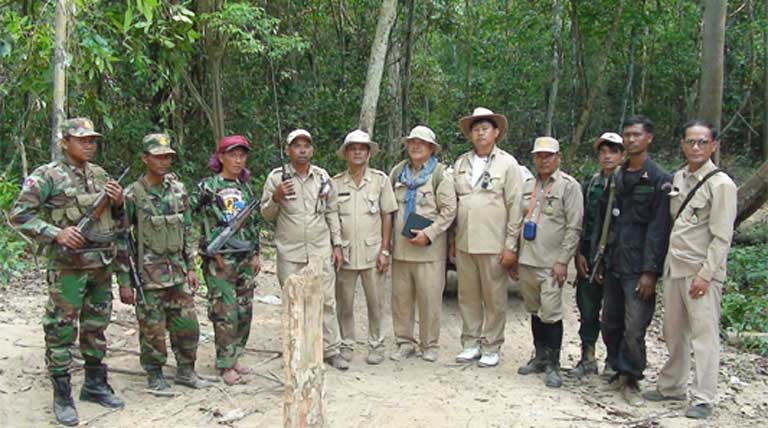
SMART, in combination with broader capacity building, has had a real impact in the Northern Plains. Since 2013, protection of important Pileated Gibbon habitat has improved dramatically as the number of patrol staff has nearly doubled. Thirty personnel have conducted 746 patrols, covering 159,461 square kilometers (99,084 square miles). The staff have also received thorough training, including two 9-day law enforcement courses, a National SMART workshop, and two additional SMART refresher field courses. “Incredibly, during the two year period there was only a single hunting record for gibbons,” Mould said.
“SMART patrol outputs and targets ensure that forest law enforcement and governance are effective and that agreements with local communities regarding resource exploitation are respected and enforced,” Mould told Mongabay. Patrol teams are highly organized, with each targeting a 5 square kilometer (1.9 square mile) area, especially focusing on key habitat hotspots known to be at risk based on input from past patrols. The patrols are carried out in close coordination with community wildlife rangers, who play a key role in monitoring the most threatened species and key habitats in the landscape.
Community participation and empowerment is vital
Rours Vann is a WCS community research ranger team leader working in the Kulen Promtep Wildlife Sanctuary. He engages with local people and trains them in SMART data collection methods. “Since I started working in wildlife conservation over 15 years ago, I have always looked forward to waking up in my hammock, listening to sounds of gibbons calling in the forest,” he told Mongabay. “I am very proud to help to raise awareness and protect Pileated Gibbon priority habitats in the Northern Plains of Cambodia.”
Community members, employed to monitor wildlife, “are essential to the success of this project,” Mould said. But community involvement can have profound impacts beyond data collection and law enforcement, even helping to prevent forest loss by altering community behaviors, leading to local opposition to the clearing of concessions.

“There is evidence that within areas managed by recognized communities, the rates of habitat loss in recent years has been lower, because economic land concessions have been prevented from clearing land within community zones”, Mould revealed. “This provides a strong indication that strengthening local community patrolling capacity, and ensuring that land-use plans are respected, are an effective means of reducing critical semi-evergreen and evergreen habitat conversion.”
Community land use planning is a key component of the project, with the establishment of land-use rights a priority for both communities and conservation. “We use the participatory land use planning process to develop community zones around villages to ensure informed local decision-making on land use,” Mould explained.
The consultation process within the Kulen Promtep Wildlife Sanctuary has now been completed, and draft maps of the proposed zoning of all villages await ministerial approval, Mould said. However, the Preah Vihear Protected Forest falls under a different ministry’s administration, one that does not yet recognize community zoning, so sustainable use zones there are still being piloted. “This project has been working with the Forestry Administration to develop the official process to allow communities to claim land-use tenure rights and manage community forestry within Preah Vihear Protected Forest,” Mould said.
Connecting and protecting prime gibbon habitat
For some species, plantations offer a poor, but still usable, portion of their habitat through which they can travel. Orangutans can move across oil palm plantations, for example, eating the palm fruit as they go from one piece of prime forest habitat to another. Conscientious plantation owners can foster this limited biodiversity by modifying agricultural practices to better meet primate needs and by setting aside areas of high conservation value.
The Pileated Gibbon cannot benefit much from such enlightened agricultural methods. “In the Northern Plains, gibbons do not exist within plantations, and the only way for them to co-exist with plantations is when [the operations] are located adjacent to or near intact semi-evergreen/evergreen habitat,” Mould said. “I am not aware of any concession holders making efforts to protect biodiversity within the Northern Plains landscape.”
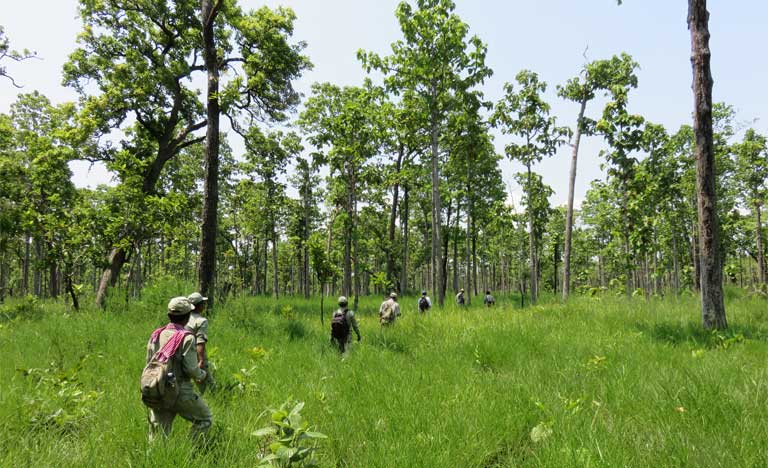
That’s why it is crucial that key core gibbon habitats be linked by forest corridors crossing the wider agricultural landscape. The chances of maintaining such connectivity in Cambodia recently received a boost with the proposal of a new protected area.
The government has indicated that a former logging concession should become the Prey Preah Roka Protected Forest, Mould said, describing the move as “one of the most important conservation outcomes to secure important Pileated Gibbon habitat. This 80,000 hectare [309 square mile] proposed Protected Forest contains the largest single block of semi-evergreen and evergreen forest in the wider landscape, and is therefore likely to support the largest numbers of Pileated Gibbon.”
Importantly, this block of forest connects directly to riverine forest in Preah Vihear Protected Forest, where Pileated Gibbon are regularly recorded.
The on-going success of the SMART program, Cambodia’s moratorium on economic land concessions, and unfolding plans for the Prey Preah Roka Protected Forest have all worked to transition the outlook for the Pileated Gibbon from deep concern to cautiously hopeful.
Mahood sees gibbon prospects as “Pretty good really. Cambodia supports most of the world population, and is still extensively forested. We have a great chance to save this species,” he said. “Without conservation, these [animals] and the unique habitats that they inhabit would be lost. They’re gone already from most places where they used to live, and the world would be a sadder place without their song in the forest.”

